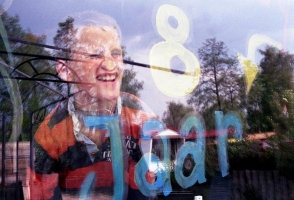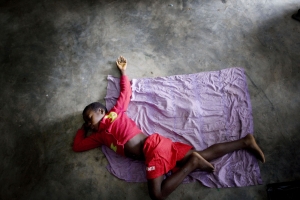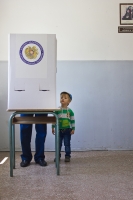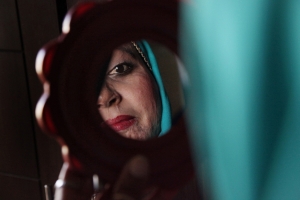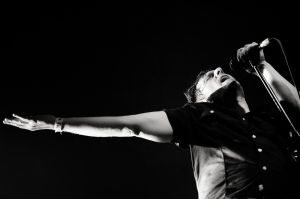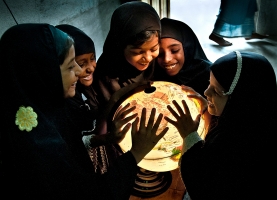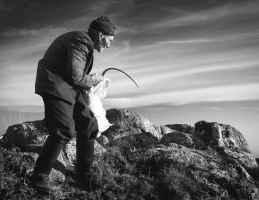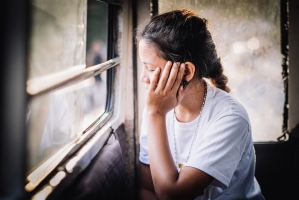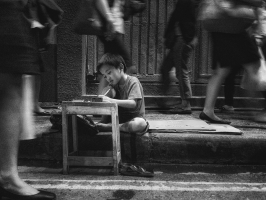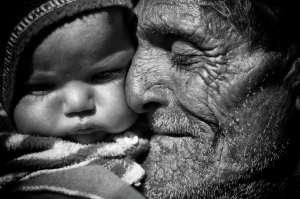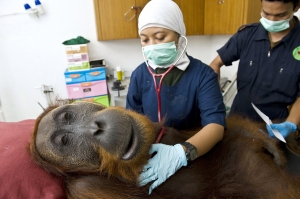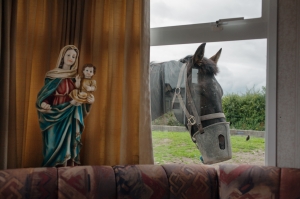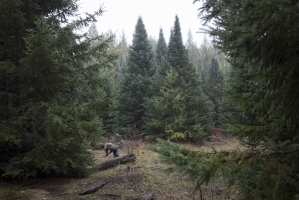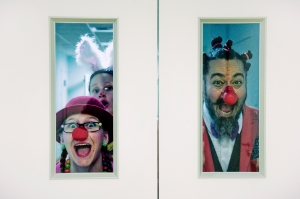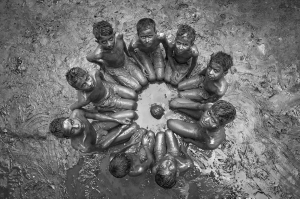The Shortlist of the Alfred Fried Photography Award 2014
Sub-Categories
-
 View here the shortlisted entries of the Alfred Fried Photography Award 2014
View here the shortlisted entries of the Alfred Fried Photography Award 2014
-
5271 images have been submitted by 1549 photographers from all five continents.
In the first step the international jury created a shortlist of 21 entries (stories as well as single images).
Out of this shortlist 6 winners and one best picture on the theme of peace were choosen.
The shortlist is in alphabetical order. Click on an image to see the complete story.
-
 Wilma Rekkers, Netherlands
Wilma Rekkers, Netherlands
-
Bradley
Bradley is only a few months old when his parents decide to recreate on camping ‘Fort Oranje’, Rijsbergen, The Netherlands. When he is 3 years old they permanently move from The Hague to the campsite. He now already lives there for five years with his father Dennis, mother Bregitta and sister Naomi.
Camping ‘Fort Oranje’ is afflicted with a bad image and therefore the once popular family camping is in decline. Bradley knows no other world, but rather experiences this world as perfect for him even though the ‘outside’ world sees it differently.
My name is Wilma Rekkers and I’m a documentary photographer and film maker. This year I graduated the photo academy in Amsterdam with an honours nomination with my project about Bradley. I followed him intensively (from September 2013 to May 2014). I hope by watching my pictures as one story the viewers just feel part of Bradley’s peaceful world and can look at him without any prejudices.
-
 Toby Binder, Germany
Toby Binder, Germany
-
Childwitches of Nigeria
These children had to go a long way to find peace.
About 160 children stigmatized as witches live in the Centre of the „Child‘s Right And Rehabilitation Network“ (CRARN) in Eket, Southeastern Nigeria. The NGO takes care of girls and boys from four to sixteen years old who have been abandoned or abused after being accused of being witches.
Evangelical pastors are helping to create a terrible new campaign of violence against young Nigerians. Children branded as evil are being abused, abandoned and even murdered while the preachers make money out of the fear of their parents and their communities. „So many people here believe that children can be possessed by demons that there is rarely any action taken against those who claim to deliver the children in violent exorcisms,“ says Sam Itauma, of the Child‘s Right and Rehabilitation Network.
Ostracised, vulnerable and frightened, she wandered the streets in south-eastern Nigeria, sleeping rough, struggling to stay alive. Stella was found by Jehu Tom, a rescue officer from CRARN and today lives at the Centre with 160 other children who have been branded witches, blamed for all their family‘s woes, and abandoned.
The devil‘s children are „identified“ by powerful religious leaders at extremist churches where Christianity and traditional beliefs have combined to produce a deep-rooted belief in, and fear of, witchcraft. The priests spread the message that child-witches bring destruction, disease and death to their families. And they say that, once possessed, children can cast spells and contaminate others. The religious leaders offer help to the families whose children are named as witches, but at a price. The churches run exorcism, or „deliverance“, evenings where the pastors attempt to drive out the evil spirits. Only they have the power to cleanse the child of evil spirits, they say.
-
 Tatevik, Vardanyan, Armenia
Tatevik, Vardanyan, Armenia
-
Future Voters
Since Armenia gained it’s independence, no election has ever been regarded as fair. This makes the people angry and aggressive every time it’s election season. In every step of the election you can see demonstrations and meetings. This year I wanted to be a part of the election process and to research and understand the elections. I became an observer for the ‘Presidential Elections of Armenia’ and the ‘Yerevan Council of Aldermen’ elections. The stories I heard before became true with these elections, I realized that my country still has a long way to go before achieving real fair elections. But one thing that gives me hope was the kids, who came with their parents to vote and to learn what and why this was all happening. The elections are now over, but the emotions on the kids faces I will never forget. Each of them was so proud to be there and to be a part of something big. The happiness I saw on the faces of these kids took me far away from the real elections happening at the same moment.
-
 Ann-Christine Woehrl, Germany
Ann-Christine Woehrl, Germany
-
IN/VISIBLE
It is their scars which draw attention to them. They are openly stared at or eyed discretely. Some people look away immediately because they feel uncomfortable or want to forget what they have just seen. It is easier for society not to acknowledge those who are different, to ignore them and thus to make them invisible. Therefore, it is not only the visible scars from which survivors of fire and acid attacks and accidents are suffering for their whole life. Above all, it is other people’s reactions to their disfigurements which are pushing them to the edge of society.
For my long-term project IN/VISIBLE I travelled to India, Pakistan, Bangladesh, Uganda, Nepal and Cambodia over the last year to portray and interview female survivors of acid and fire attacks. My approach was to closely document the daily life of one woman in each of the six country in order to show what it means to live with the stigma of an outcast.
The women I visited are just a few of the many that are attacked with acid or fire to purposely disfigure or kill them. Officially there are around 1500 acid attacks reported worldwide every year. The majority of which are women. The number of unreported cases is estimated to be much higher.
Chantheoun from Cambodia, Flavia from Uganda, Neehaari from India, Renuka from Nepal, Farida from Bangladesh and Nusrat from Pakistan, who all have experienced their own tragedy, allowed me to share intimate moments in their lives and showed me what real heroism means and to be at peace with their tragic fate. The photographs here shown are a small selection of five of them, showing their daily life, each of their struggle and their strength and determination to move on.
-
 Sasa Huzjak, Slovenia
Sasa Huzjak, Slovenia
-
Lost in Music
The main idea behind my ongoing photographic project "Lost in music" is relatively simple: capture musicians performing at the moment when they're in their own world, concentrated only on that tone, on that moment, like there is no one around.
The moment when it all makes sense.
The moment when they're lost in music.
-
 Pranab Basak, India
Pranab Basak, India
-
One world
Knowledge of peaceful world.
-
 Rui Pires, Portugal
Rui Pires, Portugal
-
Rural Moments
Rui Pires spent his childhood in Portuguese rural areas, capture the essence of the rural people has always been a challenge that has captivated him. The ease of communication between the author and rural people facilitated the process.
It all began in 2006 when the author visited "Covas do Monte" and found one of the last places where the word humanity makes sense. Simple people, workers, people for whom the word “euro” or “political” means nothing.
The author met Maria "Piqueirinha", Maria do Martins, Antonio, Frances, Anne, Luciano and many other wonderful human beings living in absolute community and work in agriculture. They help each other like a big family.
In the course of time, the author has begun to be considered a true friend and like family for all these people, and since 2007 he becomes part of their lives, their joys, sorrows, and unfortunately, to attend the passing of almost all of them.
This way of life virtually extinct, where humanity, the word, mutual assistance, help in good times and bad times still persist, I decided to start this documentary in order to show future generations these ways of life endangered in opposite to lack of humanity that happens in big cities and in modern way of life.
In this sense, for some years author traveled the paths of the mountain to follow the life of rural people, establish relationships with them so that the camera was something that they would forget. And author used a huge camera.
Unfortunately, these ways of life are disappearing and during the production of this documentary the author witnessed the death of most of his rural friends, the human elements that have been documented photographically. More than once, author has very sad moments that almost led him to abandon the project, due the strong friendship established with these people that finished in a sad way. Most of this people were very old, from 85 to 95 years old, these villages have few young people, most of them leave to big cities in order to study and get a job.
Maybe this way of life became to be the future again, with the lack of jobs, the fall of the industry in Europe and the crisis. In “Rural Moments” villages, the word crisis is unknown, maybe because this is the last places where the word “humanity” makes sense.
All photographs taken in with medium format 6x7 film camera in Kodak Tri-X Pan 320 and developed by author, in order to give a timeless feeling to the project.
-
 Insa Hagemann, Stefan Finger, Germany
Insa Hagemann, Stefan Finger, Germany
-
Safehouse
Ten girls sleep at the same time in a room with broken bunk beds and ornate iron bars on the window. All are between 14 and 18 years old and all girls are victims of sexual exploitation. Now they start a new life at the Preda Safehouse. A social worker is available 24 hours a day. "The sex industry is war. We have many victims“, says Father Shay Cullen, the founder of NGO Preda in Olongapo, Philippines. Preda helps the victims of sexual exploitation. At its safehouse, victims of sex tourism get treated and find protection from traffickers, sex tourists and even protection from their own family.
Erica is now eighteen years old. For more than two years she has lived in the Preda safehouse, thanks to her adult sister. She had heard that Erica was sold to sex tourists, for "work" at an hourly fee. While other parents are trained by social workers at Preda to act accordingly in cases of sexual abuse and how to treat their child if she is returned to them, there is no turning back for Erica. While Erica had to do in the hotel room, what European and American pedophiles thought up in their imagination, her own mother waited outside the Rajah Motel in Angeles City and collected money from them. Every time when the money in the family was scarce. The sex tourists leave behind generations of girls like Erica whose childhood was cut short in bars by sexual acts forced upon them.
"It's nice to see how life comes back to them," says Cullen as he watches them play. Erica is asked to draw her bad memories, she paints a rainbow landscape. She says that the house symbolize Preda. Here she feels safe and secure.
-
 Jeffrey Itum, Philippines
Jeffrey Itum, Philippines
-
Street Genius
It was 6:30 in the evening and i cant find a ride, from not that quite far, in front of those busy roads where i stand from, I figured out an image, a child, a busy child in his own world doing his thing with his petite table, bag and a carton to serve as a chair and also a bed, that kid was studying not minding the world around him, the busy people walking, not giving a damn for those noises of vehicles passing by. I glanced then suddenly didn't notice that I was already staring at him. I was amused, applauded him inside my mind, respected that kid, I respect him a lot. I grabbed my phone, crossed the street to take that picturesque moment. I didn't care if I would be bumped by a car or what, I motivated myself with, is that I need to take a photo of that wondrous kid. After I took a photo of him, I approached his mother whose selling fruits and I made her see the photo, she was amazed for what she saw there was a sudden bliss in her eyes, she was proud of her son. I touched the head of the kid then I told him.. "You can do it boy, push it!"
"For me this image speaks out that even though we have tribulations in life, though we have problems in life we shouldn't give up to reach for our dreams and goals cause we will get it, we'll achieve it thru perseverance, hard work and simply believing on what we can do, on trusting ourselves we will never go wrong."
-
 Hardik Gaurav, India
Hardik Gaurav, India
-
The Circle of Life
This is a photo, I clicked in a small village called Dhinkli in Udaipur (India), during our Anthropological fieldwork. The old man held his grandchild & hugged him in such a manner, that his expressions were revealing how much he loved him & the some kind of strange emotional peace I spotted which I could resist but freeze it at that very moment. What I love about this photo is the contrast that it showcases which could be very well be compared to the concept of what we called Circle of Life, you born as child & you grow old & then rebirth takes place.
-
 Sandra Hoyn, Germany
Sandra Hoyn, Germany
-
The last Orangutans
Orangutans, an entirely Asian species in the family of great apes, roam Indonesian rain forests on the islands of Sumatra and Borneo. During the past decade, orangutan populations in the wild have decreased by approximately 50%. They are currently listed as ‘Critically Endangered’ by the IUCN (International Union for the Conservation of Nature and Natural Resources). Human activities, especially the unchecked burning of rain forests to clear land for palm oil plantations, have resulted in a critical loss of habitat, driving orangutans to the brink of extinction in Indonesia.
Indonesia is market leader in global palm oil production. Palm oil is used for food, cosmetics and as biofuel. The last forests are destroyed to grow more oil palms. Palm oil plantations are replacing four-fifths of the rainforest in Indonesia. Orangutans are one of many victims of massive deforestation.
The aim of the Sumatran Orangutan Conservation Programme (SOCP) is to conservate the last Sumatran orangutans. Members of SOCP are supporting orangutan conservation, rainforest protection and reintroduction of orphans in order to save the species from extinction. Their vision is that all orangutans live in the wild in secure and in peacful coexistence with human beings.
-
 Birte Kaufmann, Germany
Birte Kaufmann, Germany
-
The Travellers
My photography project „The Travellers“, gives insight into the everyday life of Ireland’s largest minority group. This group has a nomadic origin, stemming from the tradition of migrant workers. As this tradition no longer exists, the travellers are looking for a new identity within the Western European society of the 21st century. Both the travellers’ traditions and their way of life are so different that they are met with little acceptance by the rest of the Irish society. The travellers live in a kind of parallel world with rules all of its own and traditional gender roles, a world to which outsiders have little access.
To this day, some traveller families live by the roadside illegally – mostly without electricity, running water or sanitation, even though the government has provided halting sites for the travellers where they can stay with their caravans.
In the summer of 2011, I travelled the first time to Ireland with a VW bus in order to photograph the travellers. I wanted to capture the travellers’ way of life and their values in pictures. In doing so, I did not want to romanticize them, but rather show their everyday life. A life where people still hunt rabbits and where horses play a vital role. But it is also a life that contains hardship and boredom from an early age.
Since my first encounter with the travellers, I have been in touch with one large family. Over time, I have gained their trust. Consequently, I was allowed to live with them so that I and my camera became part of their daily lives.
-
 Veronika Lindlbauer, Germany
Veronika Lindlbauer, Germany
-
Waldmonde
They live like Hunters and Gatherers. They live off the grid. They practice bow shooting, use the bow drill to start a fire and they receive their food, clothes and medicine from plants and animals. They live in the wilderness and they live off the land.
With the Teaching Drum Outdoor School, Tamarack created a space where people are helped to connect to the earth, learn ancient skills and traditional ways of living, based on the traditions of the Ojibwe - people. They attune their senses and awake their intuitive abilities. They relearn to speak from the heart, rather than the ego. This series of pictures is about those people, who decided to live in this environment in order to focus on a simple life in accordance with nature, instead of putting their effort in a way of living, that is led by consumption and materialism.
-
 Arthur Bondar, Oksana Yushko, Russia
Arthur Bondar, Oksana Yushko, Russia
-
Ward Number Laughter
Project by Arthur Bondar and Oksana Yushko
My grandfather always said: “A journey of a thousand miles begins with a single step”. Taking the first step is all it takes. Everyone always has a choice which path to follow. You don’t have to go far to give your love. Just take a look around, and you will definitely find a person in need of your help or your smile at the least. Smiles are often the starting point in a photographers’ dialogue. Foreign volunteers that visit orphanages, hospitals and nursing houses usually don’t speak any Russian, and their smiles become the first instrument they use, the first step in making a connection. Your life becomes easier, when you are no longer afraid of being silly in the eyes of other people. Becoming part of this process by wearing clown costume and smiling at strangers results in a much richer experience, as opposed to just staying behind the lens. It is difficult to recall the faces of each and every man, woman and child that we met, but we do remember the smiles we saw on their faces. By deciding to be an active participant, rather than a documentary photographer, you realize that some of the things that are happening depend on you as well, personally. And not a single moment was spent in vain: every single touch, every sound of laughter, every flash of desire to ease away another person’s pain and give them some comfort – all of them are reflected back around the world. The more you think about these things, the more you want to give and share.
-
 Sujan Sarkar, India
Sujan Sarkar, India
-
Winged Birds
Life has three stages: Childhood,Youth, Old age. Among the three, the childhood is the most beautiful part of our life. Plants and grains grow badly if there is no rain in early spring. So, our Childhood should not be confined only within the boundary of education,but it must be enjoyed to the fullest to make the life beautiful. The children are the symbol of Unity and peace. Unity can make a positive change. Here the children in their playful mood is delivering this message to the whole world. Sometimes our joy is the source of our smile, but sometimes our smile can be the source of our joy.
